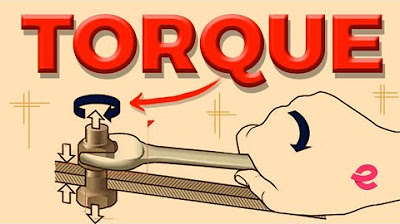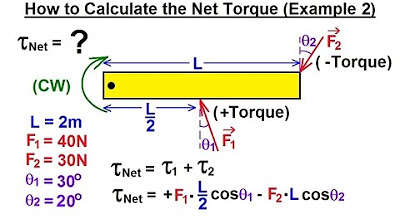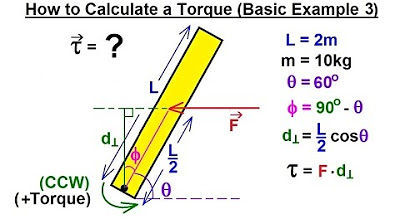Torque is a Vector | Physics with Professor Matt Anderson | M12-11
TLDRIn this educational transcript, Professor Anderson delves into the concept of torque, emphasizing that it is a vector quantity with a specific direction, determined by the right-hand rule. He simplifies the concept by focusing on two dimensions, using the example of a door opening in a counterclockwise direction, which is considered positive torque, and a clockwise direction, which is negative. The professor illustrates the principle by comparing two people applying force to open a door. One person pushes at the end of the door, while the other pushes at the middle. By calculating the torque produced by each force—taking into account the direction and the distance from the axis of rotation—the professor concludes that the person pushing at the end with a longer lever arm (full length of the door) will succeed in opening the door counterclockwise, demonstrating the practical application of torque in everyday scenarios.
Takeaways
- 📐 Torque is a vector quantity with a specific direction, which is determined by the right-hand rule.
- 🔄 When considering two dimensions, torque is positive for counterclockwise rotation and negative for clockwise rotation.
- 🚪 In the example of a door opening, the direction of rotation (counterclockwise or clockwise) is crucial to understanding torque.
- 🖐 The force applied and the point of application on the door affect the torque produced, with different outcomes based on location.
- ↕️ The axis of rotation, in this case, the hinges of the door, is central to calculating torque.
- 📏 The length of the lever arm (distance from the axis of rotation to the point of force application) is a key factor in torque calculation.
- 🔢 Torque can be calculated by multiplying the force (F) by the length of the lever arm (L), resulting in \( \tau = F \times L \).
- ➗ When multiple forces act on an object, the net torque is found by summing the individual torques, considering their directions.
- 🚶♂️ The person applying force at the end of the door generates a greater torque (positive) than the one applying force at the middle of the door (negative).
- 🏆 The door will rotate in the direction of the greater torque, in this case, counterclockwise, as the positive torque is greater than the negative.
- 🤔 The concept can be extended to three dimensions with the introduction of a Cartesian coordinate system, relating torque to the third dimension.
Q & A
What is torque and why is it considered a vector?
-Torque is a measure of the force that can cause an object to rotate around an axis. It is a vector because it has both magnitude and direction, which is determined by the right-hand rule in three dimensions.
How does the right-hand rule apply to the direction of torque?
-The right-hand rule states that if you point your right thumb in the direction of the force and curl your fingers, the direction in which your fingers curl represents the direction of the torque.
What is the sign convention for torque in two dimensions?
-In two dimensions, torque is considered positive when it causes a counterclockwise rotation and negative when it causes a clockwise rotation.
How does the direction of door rotation relate to the torque applied?
-The direction of door rotation is determined by the torque applied. If the net torque is positive, the door rotates counterclockwise. If the net torque is negative, it rotates clockwise.
What is the role of the lever arm in calculating torque?
-The lever arm is the perpendicular distance from the axis of rotation to the line of action of the force. It is used in the formula for torque, which is the product of the force and the lever arm.
How does the position of the force application affect the torque on a door?
-The position of the force application affects the torque because the lever arm, which is the distance from the axis of rotation to the point where the force is applied, changes with the position. A force applied further from the axis of rotation results in a greater torque.
What happens when two forces of equal magnitude are applied to a door, one at the end and the other at the middle?
-The force applied at the end of the door, which has a longer lever arm, will result in a greater torque and will cause the door to rotate in the direction of the applied force. The force applied at the middle, with a shorter lever arm, will have less effect on the rotation of the door.
How does the length of the door affect the calculation of torque when forces are applied at different points?
-The length of the door (l) directly affects the calculation of torque because it determines the length of the lever arm. A longer door results in a longer lever arm for a force applied at the end, increasing the torque.
In the given scenario, who wins the 'door-opening contest' and why?
-The person applying force at the end of the door wins because the torque they apply (F * L) is greater than the torque applied by the person pushing in the middle (0.5 * F * L), resulting in the door rotating counterclockwise.
What is the net torque acting on the door when two people are pushing with the same force but at different points?
-The net torque is the difference between the torques applied by the two people. In this case, it is (F * L) - (0.5 * F * L) = 0.5 * F * L, which is positive, indicating the door will rotate counterclockwise.
How can the concept of torque be simplified when considering only two dimensions?
-In two dimensions, torque can be simplified by focusing on the direction of the force relative to the axis of rotation (counterclockwise or clockwise) and the distance from the axis of rotation to the point where the force is applied (lever arm).
What is the significance of considering torque in the third dimension?
-Considering torque in the third dimension is important for understanding the full three-dimensional effects of forces on an object. It allows for a more comprehensive analysis of how forces can cause rotation in space, not just in a plane.
Outlines
🔧 Torque as a Vector with Directional Significance
Professor Anderson introduces the concept of torque as a vector with a specific direction. He explains that torque's direction is determined by the right-hand rule and simplifies the concept for two dimensions, where counterclockwise rotation is considered positive and clockwise rotation is negative. Using the example of a door being opened, he illustrates how torque can be calculated and compared when two forces are applied to the door at different points. The person applying force at the end of the door, which results in a longer lever arm, generates a greater positive torque, thus overcoming the negative torque from the person pushing at the middle of the door. Consequently, the door rotates counterclockwise, indicating that the first person 'wins' the scenario.
Mindmap
Keywords
💡Torque
💡Vector
💡Right-Hand Rule
💡Two Dimensions
💡Counterclockwise
💡Clockwise
💡Axis of Rotation
💡Lever Arm
💡Summing Torques
💡Force
💡Rotation
Highlights
Torque is a vector with a particular direction.
The direction of torque is governed by the right-hand rule.
In two dimensions, torque can be considered without the third dimension.
Torque is positive when rotating counterclockwise and negative when rotating clockwise.
In three dimensions, torque is into or out of the board.
Torque can be visualized using a Cartesian coordinate system.
A door serves as an example to illustrate the concept of torque.
Different forces applied to a door result in different torques.
The force applied at the end of the door creates a positive torque.
The force applied at the middle of the door creates a negative torque.
The lever arm is the distance from the axis of rotation to the point where force is applied.
The sum of torques determines the direction of rotation.
The person applying force at the end of the door will win the 'door-opening contest'.
The door will rotate counterclockwise due to the greater positive torque.
The person pushing at the middle of the door is less effective due to a shorter lever arm.
The mathematical representation of torque is given by the formula: torque = force × lever arm.
The door-opening scenario demonstrates the practical application of torque calculations.
Understanding torque is crucial for predicting the outcomes of mechanical interactions.
Transcripts
Browse More Related Video

What is Torque? | Physics | Extraclass.com

Torque as a Cross Product | Physics with Professor Matt Anderson | M12-08

Physics 15 Torque Fundamentals (11 of 13) How to Calculate the Net Torque? Ex. 2

Calculating Torque

Physics 15 Torque Fundamentals (9 of 13) How to Calculate a Torque (Basic Example 3)

Angular Momentum and Cross Product | Physics with Professor Matt Anderson | M12-15
5.0 / 5 (0 votes)
Thanks for rating: